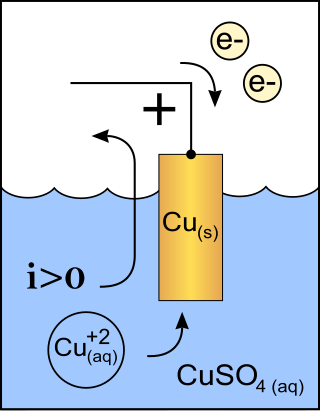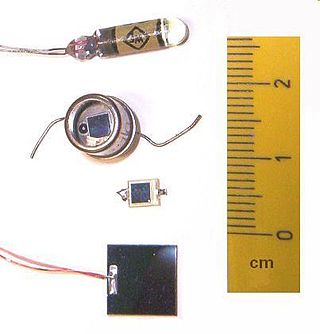Related Research Articles

A cathode is the electrode from which a conventional current leaves a polarized electrical device. This definition can be recalled by using the mnemonic CCD for Cathode Current Departs. A conventional current describes the direction in which positive charges move. Electrons have a negative electrical charge, so the movement of electrons is opposite to that of the conventional current flow. Consequently, the mnemonic cathode current departs also means that electrons flow into the device's cathode from the external circuit. For example, the end of a household battery marked with a + (plus) is the cathode.

A diode is a two-terminal electronic component that conducts current primarily in one direction. It has low resistance in one direction, and high resistance in the other.

A photodiode is a light-sensitive semiconductor diode. It produces current when it absorbs photons.

A Zener diode is a special type of diode designed to reliably allow current to flow "backwards" when a certain set reverse voltage, known as the Zener voltage, is reached.
In electronics, an avalanche diode is a diode that is designed to experience avalanche breakdown at a specified reverse bias voltage. The junction of an avalanche diode is designed to prevent current concentration and resulting hot spots, so that the diode is undamaged by the breakdown. The avalanche breakdown is due to minority carriers accelerated enough to create ionization in the crystal lattice, producing more carriers, which in turn create more ionization. Because the avalanche breakdown is uniform across the whole junction, the breakdown voltage is nearly constant with changing current when compared to a non-avalanche diode.

In electronics, a Schmitt trigger is a comparator circuit with hysteresis implemented by applying positive feedback to the noninverting input of a comparator or differential amplifier. It is an active circuit which converts an analog input signal to a digital output signal. The circuit is named a trigger because the output retains its value until the input changes sufficiently to trigger a change. In the non-inverting configuration, when the input is higher than a chosen threshold, the output is high. When the input is below a different (lower) chosen threshold the output is low, and when the input is between the two levels the output retains its value. This dual threshold action is called hysteresis and implies that the Schmitt trigger possesses memory and can act as a bistable multivibrator. There is a close relation between the two kinds of circuits: a Schmitt trigger can be converted into a latch and a latch can be converted into a Schmitt trigger.

A p–n junction is a boundary or interface between two types of semiconductor materials, p-type and n-type, inside a single crystal of semiconductor. The "p" (positive) side contains an excess of holes, while the "n" (negative) side contains an excess of electrons in the outer shells of the electrically neutral atoms there. This allows electric current to pass through the junction only in one direction. The p- and n-type regions creating the junction are made by doping the semiconductor, for example by ion implantation, diffusion of dopants, or by epitaxy.

A current source is an electronic circuit that delivers or absorbs an electric current which is independent of the voltage across it.

A single-photon avalanche diode (SPAD) is a solid-state photodetector within the same family as photodiodes and avalanche photodiodes (APDs), while also being fundamentally linked with basic diode behaviours. As with photodiodes and APDs, a SPAD is based around a semi-conductor p-n junction that can be illuminated with ionizing radiation such as gamma, x-rays, beta and alpha particles along with a wide portion of the electromagnetic spectrum from ultraviolet (UV) through the visible wavelengths and into the infrared (IR).
An IMPATT diode is a form of high-power semiconductor diode used in high-frequency microwave electronics devices. They have negative resistance and are used as oscillators and amplifiers at microwave frequencies. They operate at frequencies of about 3 and 100 GHz, or higher. The main advantage is their high-power capability; single IMPATT diodes can produce continuous microwave outputs of up to 3 kilowatts, and pulsed outputs of much higher power. These diodes are used in a variety of applications from low-power radar systems to proximity alarms. A major drawback of IMPATT diodes is the high level of phase noise they generate. This results from the statistical nature of the avalanche process.

A voltage-regulator tube is an electronic component used as a shunt regulator to hold a voltage constant at a pre-determined level.
A shunt is a device that is designed to provide a low-resistance path for an electrical current in a circuit. It is typically used to divert current away from a system or component in order to prevent overcurrent. Electrical shunts are commonly used in a variety of applications including power distribution systems, electrical measurement systems, automotive and marine applications.

A microwave power meter is an instrument which measures the electrical power at microwave frequencies typically in the range 100 MHz to 40 GHz.

An electronic component is any basic discrete electronic device or physical entity part of an electronic system used to affect electrons or their associated fields. Electronic components are mostly industrial products, available in a singular form and are not to be confused with electrical elements, which are conceptual abstractions representing idealized electronic components and elements.

Avalanche breakdown is a phenomenon that can occur in both insulating and semiconducting materials. It is a form of electric current multiplication that can allow very large currents within materials which are otherwise good insulators. It is a type of electron avalanche. The avalanche process occurs when carriers in the transition region are accelerated by the electric field to energies sufficient to create mobile or free electron-hole pairs via collisions with bound electrons.

In electronics, noise is an unwanted disturbance in an electrical signal.

A noise generator is a circuit that produces electrical noise. Noise generators are used to test signals for measuring noise figure, frequency response, and other parameters. Noise generators are also used for generating random numbers.

In electronics, the Zener effect is a type of electrical breakdown, discovered by Clarence Melvin Zener. It occurs in a reverse biased p-n diode when the electric field enables tunneling of electrons from the valence to the conduction band of a semiconductor, leading to numerous free minority carriers which suddenly increase the reverse current.
The following outline is provided as an overview of and topical guide to electronics:
In electronics, excess noise ratio is a characteristic of a noise generator such as a "noise diode", that is used to measure the noise performance of amplifiers. The Y-factor method is a common measurement technique for this purpose.
References
- Keysight (June 2009), Keysight 346A/B/C Noise Source (PDF)
- Hewlett-Packard (May 1985), HP 8970A Noise Figure Meter: Operating & Service Manual (PDF) (29MB download)
- Motchenbacher, C. D.; Fitchen, F. C. (1973), Low-Noise Electronic Design, New York: John Wiley & Sons, ISBN 0-471-61950-7
- Ott, Henry W. (1976), Noise Reduction Techniques in Electronic Systems, New York: John Wiley & Sons, ISBN 0-471-65726-3
- Swain, Howard L.; Cox, Rick M. (April 1983), "Noise Figure Meter Sets Records for Accuracy, Repeatability, and Convenience" (PDF), HP Journal, 34 (4): 23–34
Also
- HP Application notes
- Newer generation manuals
- Ailtech fixed IF